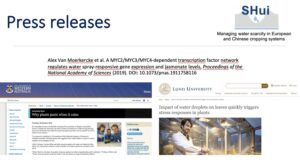Science communication webinar for researchers
Early on a March Friday morning, at least for UK and EU participants, 40 scientists from 7 countries (Austria, China, Czech Republic, Greece, Italy, UK and Spain) dedicated their time to better understanding the news cycle to ensure their research is accessible to the general public. The session was convened on Zoom, presented by Isabel Mendoza (SHui’s community engagement officer) and open to those inside and outside of the consortium. Goals of the training were to introduce participants to necessary skills to increase the societal impact of their research and to help SHui consortium members populate the SHui and EIP-Agri websites with practice abstracts of SHui outputs in a language accessible for farmers and end-users.
While scientists often communicate in very precise terms by qualifying their message and introducing (statistical) uncertainty, this does not necessarily apply to science journalists in search of a good story. Ideally, work with the journalist to ensure you are quoted correctly within the specific context you recognise.
An excellent illustration of this is the cartoon below, where a mere correlation (eagle-eyed readers will recognise it’s not statistically significant!) has resulted in behavioural change as successive “news reporters” sought to enhance the possibilities.
A challenge may be that much research, although contributing to a broader understanding, is context-dependent or incremental. While all scientists might aspire to publish in Nature or Science, not all outputs even in these journals are likely to attract journalist attention. Nevertheless, well-crafted press releases, reports and even blog posts can attract significant attention, and University Press Offices can play a vital role in disseminating news stories post-publication. As part of the session, we reviewed 2 headlines released by different institutions following collaborative research, and it was telling how important a good headline was. “Panicking plants” trumped “stress-responsive genes”!

It was pleasing that the audience was prepared to interact via polls in the online chat and commented on a range of items related to the newsworthiness of the press releases discussed. Namely: reputation, expertise, authenticity, research group visibility, deep citizen engagement, current issue in the public sphere, closeness, newness, reproducibility and human interest.
As a follow-up, SHui researchers were invited to set up a one-to-one meeting during the SHui assembly in Murcia in April with Isabel Mendoza to discuss their writing samples or contact her at any time via email.

Resources
Slides are available here.
Webometrics (CSIC) provides tools to check online visibility of Universities and Research Centers.
